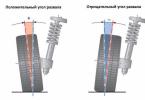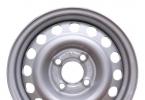29730 / 05.10.2010 / Now Mercedes-Benz Actros tractors are assembled in Russia
On September 30, 2010, the assembly production of Mercedes-Benz heavy trucks was launched in Russia. The first truck to be assembled in Naberezhnye Chelny on the production line of Mercedes-Benz Trucks Vostok is the brand's flagship in the international transportation segment, Mercedes-Benz Actros 1841 LS. Mercedes-Benz Trucks Vostok, a joint venture between Daimler AG and OJSC KAMAZ, began operations in early 2010 as a general importer of Mercedes-Benz trucks and special vehicles in Russia. Its priority tasks included not only the expansion of the dealer network and the network of authorized service partners, but also the organization of the assembly of Mercedes-Benz trucks in Russia. To carry out the latter task, Mercedes-Benz Trucks Vostok has chosen a production site in the city of Naberezhnye Chelny. For 10 months, training of technical personnel was carried out in Germany, original equipment was purchased and rebuilt, allowing to assemble up to 4500 vehicles per year. The assembly line started working on September 30th. “This is an important historical moment for Mercedes-Benz,” says Boris Billich, General Director of Mercedes-Benz Trucks Vostok, “for the first time a Mercedes-Benz car is produced in Russia. This shows how strongly we are interested in the Russian market, in increasing our share on it. This is also an important milestone in the cooperation of the shareholders of our company - KAMAZ OJSC and the Daimler AG concern, who joined forces to maintain the position of Mercedes-Benz trucks in Russia ”. The range of trucks that will be assembled at the Mercedes-Benz Trucks Vostok plant in Russia is practically unlimited. At first, orders for Mercedes-Benz Actros and Axor will be mainly processed, however, with an increase in sales volumes, Mercedes-Benz Atego and special trucks - Mercedes-Benz Zetros and Unimog will also be available for assembly in Naberezhnye Chelny. In 2011, the assembly of the updated Mercedes-Benz Axor and Atego models will begin, the world premiere of which took place in September at the IAA-2010 commercial vehicles exhibition in Hanover. The quality of trucks assembled in Russia will be absolutely identical to analogs produced at factories in Germany or Turkey. Jan Breded, Technical Director of Mercedes-Benz Trucks Vostok: “Mercedes-Benz has more than 40 years of experience in successfully organizing vehicle assembly in more than 50 countries around the world. This gives us the confidence that well-trained employees and 100% original components will ensure that Mercedes-Benz's high quality standards are met. ” Compliance with quality standards, according to Konstantin Kogogin, Sales and Marketing Director of Mercedes-Benz Trucks Vostok, is the main principle of the company as a whole: “We strive not only to increase the number, but also to improve the quality of our dealers and service partners. And we are confident that with Russian-made cars we will be able to meet the needs of our customers even better ”. MB Trucks Vostok LLC A joint venture between Daimler AG and OJSC KAMAZ - Mercedes-Benz Trucks Vostok was established in 2010 and is the general importer of Mercedes-Benz trucks and special vehicles, as well as Mercedes-Benz buses and Setra in Russia. The company sells Mercedes-Benz trucks through a dealer network of 20 official dealer centers in the largest regions of Russia. Qualified technical maintenance is offered by 32 authorized service centers in the Russian Federation, as well as the largest network of service stations in Europe, operating around the clock, seven days a week. Mercedes-Benz Actros 1841 LS A semitrailer tractor designed for operation as part of a road train with a gross weight of up to 44 tons. The car is equipped with a V-shaped 6-cylinder engine with a maximum power of 408 hp. and a torque of 2000 Nm. High-tech electronic systems and a 12-speed Mercedes PowerShift gearbox with automatic gear shifting, as well as equipping the cab with air conditioning, an independent air heater, a refrigerator and two comfortable berths make the Actros 1841 LS one of the most comfortable, safe and efficient trucks in the international transport segment.
Five years is not an age for a car factory. And almost 8,000 trucks produced - not the volumes that Daimler AG could be proud of. Another thing is important: the plant in Naberezhnye Chelny is the first for Mercedes in the post-Soviet space and works despite the crisis.
The assembly plant is located three kilometers from the territory of KamAZ - in the Master technopark. Last summer, an internal partition was demolished that previously separated the assembly shops of Mercedes-Benz and Mitsubishi Fuso Canter trucks.
Concern Daimler AG is the main shareholder of Mitsubishi Fuso Truck and Bus with a share of almost 90%. In 2009, an agreement was signed with Mitsubishi Fuso on the establishment of the Fuso KamAZ Trucks Rus JV. Since this summer, the Russian-Japanese joint venture has become part of OOO Mercedes-Benz Trucks Vostok. This production site is the only one in the world where Mercedes-Benz and Mitsubishi Fuso trucks are made at the same time.
WHAT'S ON THE CONVEYOR?
The budget Mercedes-Benz tractor for Russia is Axor in 1835 LS and 1840 LS versions.
As a chassis for an isothermal van, the Axor 1824 L is produced, but if you wish, you can also hook up a trailer to it. For carriers who prefer the flagship model, a relatively inexpensive tractor is assembled, and for heavy work with a trawl or a dump semi-trailer - a 6 × 4 truck tractor, structurally close to the chassis for Actros 3336 K.
A relatively new direction is the three-axle Actros 2541 L 6 × 2 for the installation of an isothermal van. If you use a two-axle trailer with a through loading, you can successfully transport dumplings and ice cream to the Dalnyak. In general, Mercedes will be assembled to the customer in any specification.
The medium-duty Atego is mainly model 1222. It is important that the Chelny Atego has a total weight of 11 990 kg. Now the number 12 (if in tons) has become special for Russian carriers - at least for those who want to stop by the Moscow ring road in the afternoon. The trend of bans and tolls is slowly spreading across the country, so the 12-ton Atego promises to be a bestseller.
Mitsubishi Fuso Canter with a gross weight of 7.5 tons ceased to be assembled in April (before that, almost 6900 cars were made). But in September the conveyor was started up again. Latest version of Kanter: 8.5 tons, 180 hp, Euro-4 with EGR.
DOMESTIC PRODUCT
Mercedes-Benz trucks assembled in Naberezhnye Chelny are recognized as domestic vehicles, and therefore they are provided with state support: scrappage, preferential leasing and trade-in programs are in place. Thanks to this, the buyer will be able to save money, and the cars themselves are slightly cheaper than purebred German cars. In Chelny, frames are assembled from parts supplied by Europeans. Nizhnekamsk tires, brands. Plus, domestic gear oil and other technical fluids, coarse fuel filters, truck saddles, dump trucks and vans. The rest comes from Germany.
The nearest plans are to localize the production of 12.00 R24 tires, steel wheels, batteries, digital tachographs. Then comes the turn of small leaf springs, intercooler heat exchangers and Grammer seats from neighboring Elabuga. A little later, Russian steel fuel tanks, plastic tanks for.
It is highly probable that the KAMAZ production will arrange the assembly of the third-generation Actros cabs and Mercedes drive axles.
WITH A LARGE STOCK
Actros and Axor share the same frames, suspension and axles. This greatly simplifies the supply of components and assembly. They have little in common with Atego. In general, it stands alone.
But all Chelny's Mercedes still have something in common - Euro-5 engines with a mini-injection pump that is individual for each cylinder. During the transition from Euro-3 to Euro-4, the Germans used SCR technology (injection of an aqueous solution of urea into the engine exhaust gases), calling it BlueTec. With it, fuel consumption is reduced by 7%
Any Mercedes-Benz truck will be assembled in Chelny on order, up to the elite versions of ActrosThe power of the V8 OM 502 engine (510–653 hp) is considered excessive in our country. The Russian Actros have a more modest diesel - V6 OM 501 LA (11.94 liters, 320–476 hp).
The Axor is usually equipped with in-line sixes OM 457 (354–428 hp) and OM 906 (6.37 liters, 238 hp). The second engine is rather weak for a tractor in a 40-ton harness, but for a single truck with a total weight of 18 tons, its capabilities are quite enough.
Another four-cylinder engine is installed on the Atego - OM 924 (4.8 liters, 218 hp).
BIG FAMILY
Each model of Mercedes-Benz trucks produced in Chelny can have about two hundred modifications: with a manual transmission or with a PowerShift 2 automatic, with leaf spring suspension or with pneumatic suspension. Axor does not have more than three axles (wheel arrangements 4 × 2, 4 × 4, 6 × 2, 6 × 4), but Actros can be four-axle, moreover, all-wheel drive. For some cars, up to a dozen wheelbase options are available - even a nine-meter van will be mounted. Since 20-meter road trains are allowed in Russia, it will be possible to create a very advantageous “coupling” in work.
The most common cab of the Russian Actros is with a sleeping bag, long, series L. It has three roof heights. The lowest is the cab for car transporters: from floor to ceiling 140 cm. The cab with one bunk has an average height of 156 cm. And the highest is the cab with two bunks: 192 cm. You can order any finish, up to a quilted leather mat on floor. They don't save on electronics either: from rain and light sensors to adaptive cruise control.
The Axor and Atego cockpits are made on the same base. The frame and most of the panels are the same. They are narrower than the Aktros cab - their width is only 2300 mm. In the Mercedes classification, a short cab with a low roof is designated S; there is no berth in it, it is in its pure form the cab of a delivery truck. Long and high is called L, but it can also have a low roof. Internal height - 151 or 191 cm. The length of the Axor sleeping bunks is 2 meters, but they are narrow: the lower one - 685 mm, the upper one - 700 mm.
On machines with a low cab, a solid step formed between the roof of the cab and the roof of the van is covered with a fairing. An alternative is the installation of a refrigeration unit.
Stylistically, the Atego and Axor cabs are similar to the flagship Aktros - some interior details are generally the same. There are multifunctional steering wheels - they allow you to enter the trip computer menu, see the mileage before maintenance or fuel consumption, control the audio system or phone. In fact, the functions of many of the buttons previously located on the dashboard have been transferred to the steering wheel. At the same time, it is important that the electronic on-board system has not undergone fundamental changes. And for Russia it is doubly important that the car is recognizable on the road, understandable for the carrier and has a predictable resource.
How much has been done?
As of July 1, 2015, 7812 Mercedes-Benz cars were produced in Naberezhnye Chelny. Of these, 4672 Actros of various modifications (from 4 × 2 truck tractors to 8 × 4 chassis), 2585 Axors and 520 Atego. In addition, 35 Unimogs have been collected.
September marks five years since the start of production of Mercedes-Benz trucks at the plant in Naberezhnye Chelny. Despite the crisis, Daimler's first enterprise in the post-Soviet space is developing new directions: in particular, it is ready to offer customers a medium-tonnage Atego model 1222 with a gross weight of 11,990 kg, which clearly promises to become a bestseller. We will tell you how the assembly production of Mercedes-Benz in Russia lives today and why Chelny cars with a three-beam star are cheaper than purebred German ones.
Volvo Truck was the first to build its Russian plant - near Kaluga, in an open field. The subsidiary Renault Trucks received half of it (it began assembly later and without an official ceremony). Last fall Scania came into play: its assembly plant opened near St. Petersburg, in a rented warehouse building. As a result, over the past year, Volvovites assembled 1,236 vehicles on Russian soil, Renault 253 trucks, and Scania immediately picked up a good pace, producing 333 vehicles, mostly complete dump trucks.
And only now Mercedes has joined them - no longer independently, but with the help of KAMAZ. Isn't it too late? In this case, better late than never! Because Mercedes almost lost the Russian cargo market.
Until the end of 2009, one company, Mercedes-Benz Automobiles LLC, was engaged in the sale of Mercedes-Benz trucks and cars. And if she was doing fine with cars, then with big trucks - alas. While competitors were increasing supplies, opening branches and service stations, creating factories in Russia or near its borders (I mean the Polish MAN plant, focused on the CIS), Mercedes slept.
Only when it became clear that the market was about to be lost did the Germans catch on and urgently created a joint venture with KAMAZ, Mercedes-Benz Trucks Vostok (abbreviated MBTV), to which the entire "cargo" business was transferred, with the exception of light vans. It was headed by the German Boris Billich, and the director of sales and marketing became - who do you think? - Konstantin Kogogin, son of the general director of KAMAZ Sergey Kogogin. So KAMAZ is now a full-fledged family concern ...
The business of the Mercedes went smoothly. Sales increased, new dealers appeared. And now the assembly of Mercedes has begun in Naberezhnye Chelny! True, this is not a full-fledged production, as at Volvo in Kaluga and Scania in St. Petersburg: cabins, engines and other components are supplied there separately, and a model in the required configuration is assembled from them on the spot. And Mercedes come to Naberezhnye Chelny in the form of "ready-made constructors", fully disassembled vehicle kits (CKD). This technology is simpler (unpack the boxes - and work with a wrench!), But it is less progressive and not flexible.
It should be noted that the assembly of Mercedes has nothing to do with the conveyor production of the KAMAZ trucks themselves: the production of Mercedes is located in one of the workshops of the giant KIP-Master building, which is leased to KAMAZ partners (KIP is the Kamsky Industrial Park). Space in KIP-Master is rented by more than 130 companies of various profiles: manufacturing, warehouse, engineering.
It is here that Daimler already assembles light Mitsubishi Fuso trucks, and now, in the neighboring workshop, also Mercedes, the latest model, the same as in Germany.
Most of the Mercedes assemblers already have experience of working at other car factories: some came from KAMAZ, others from the neighboring production of Sollers. According to the workers, the salaries are not very high, comparable to those of KAMAZ (about 16 thousand rubles), but various bonuses and bonuses are added to them - and as a result, the amount almost doubles.
Druzhba - Freundschaft: on the left - the director of the joint venture Boris Billich, on the right - the director of sales and marketing Konstantin Kogogin
Before graduation, the Pesonal studied in Germany for ten months, and now among the 60 workers there are about a dozen in black, not blue overalls: these are Germans working on a rotational basis. They train our people for a month, then leave for their homeland, changing with a new brigade. There is even an unspoken competition between our and German workers in the quality of assembly: they say that ours are already winning ...
According to unofficial information, several copies were collected even before the creation of production, at KAMAZ sites - in order to have time to certify the models before January 1, 2010 and so that they could meet Euro 3 standards (cars certified after this date must comply with Euro 4).
The first "official" vehicle, the Actros 1841LS tractor, was made in Chelny on September 30 last year. But now the Actros are produced here only in the form of construction chassis.
And the basic model is the budget Axor 1835LS and 1840LS tractors. They have in-line six-cylinder Euro 3 engines with a capacity of about 350 and 400 hp, a gearbox with a lever (and not with a joystick, as in German counterparts), air suspension at the rear. The equipment is quite decent: a 650-liter fuel tank, a differential lock, power windows, additional cab insulation, a 2 kW air “hairdryer” - and, of course, a “separator” filter.
The prices are already known: Axor 1835LS costs 2 million 350 thousand rubles, a complete four-axle dump truck Actros 4141K - 4 million 400 thousand rubles.
However, by order, they are ready to assemble cars with any options, and other models will be made: Atego distribution trucks have already been certified, and in the future it is planned to assemble Zetros all-terrain vehicles and very specific Unimogs.
At the same time, there is no question of any localization: all the components are imported, and even the cabins for the Axors are brought not from Turkey (where they are also produced), but from Germany.
By the time of the opening of the plant, exactly one hundred copies were made, the production plan for 2011 is 1100 vehicles, and it is planned to sell 2500 new trucks (some of them are due to imports).

The workshop also assembles Actros construction chassis, but they are in the minority.

Chelny Mercedes can be distinguished by their VIN number, which begins with the symbols "Z9M"
0 / 0
At the same time, the management of the MBTV announced at a press conference that it had applied for preferential conditions for industrial assembly: this will allow the import of components with zero duties. Wait a minute! But for this, according to the existing laws, it is necessary in eight years to produce 350 thousand cars with a localization of at least 60% ... Is MBTV capable of such a thing? After all, the design capacity of the enterprise is only 4500 trucks per year.
It turns out that the application was submitted not by MBTV itself, but by the main shareholder of KAMAZ, the state corporation Russian Technologies, which includes both KAMAZ and VAZ. "You need to know who to be friends with!" - Konstantin Kogogin smiled, gesturing towards the head of Russian Technologies Sergey Chemezov.
Further development of events can be assumed. In Germany, the Actros and Axor will soon be phased out and will be replaced by a completely new series, the engines for which are described in the same issue. And the models outdated for Western Europe will be produced in the “third world countries” - Russia and Turkey (see the note on the same page).
But assembly is still half the battle. Because Mercedes components will soon appear on KAMAZ trucks! An agreement has already been reached on the production of bridges, then the production of cabins will be established (apparently from Axor: there are rumors that the Aktros cab will be given to the Chinese), it will also come to engines. Recently, Sergey Kogogin said that by 2020 more than 50% of KAMAZ vehicles will be equipped with Mercedes cabins, and the first KAMAZ with Mercedes components should be shown in the fall, at the Comtrans exhibition in Moscow.
And this is not even a hidden, but a clear threat to the traditional products of KAMAZ itself. After all, if in ten years it will be possible to buy relatively inexpensive KAMAZ trucks with high-quality German components, then who will need KAMAZ trucks with long-outdated cabins and engines? Perhaps the army and municipal services.
No matter how MBTV products become a cuckoo that will squeeze its progenitor out of the nest! Moreover, Daimler does not have such an experience.
Turk-Benz

At the Mercedes-Benz Turk plant in Aksaray, Turkey, where the budget Axor model, well known to domestic carriers, is produced, the production of the Actros flagship has also begun - both for Turkey itself and for export. While the cars are assembled from vehicle kits supplied from the head plant in Werth, Germany, the engines comply with Euro 4 and Euro 5. In the next five years, Daimler is going to invest 130 million euros in Turkish production: for the company, this is the third largest freight market after the Germany and Brazil.
India Benz

This is the translation of the name of the BharatBenz brand, under which Daimler will begin production of trucks in Chennai, India in 2012. Camouflaged trucks are still being tested at a test site built near the plant, but it is already known that the range will include vehicles with a gross weight of six to 49 tons. Medium and heavy models are based on the Mercedes Actros / Axor family, light models are based on Mitsubishi Canter trucks. Surely their design will be about the same as that of Indian MANs: reinforced and simplified (powerful chassis with leaf spring suspension, cabins with simple trim, not the most environmentally friendly engines). Investment in production will amount to 700 million euros. According to the company's management, by 2020 the Indian truck market will grow by 80%, and the volume of local "freight" production will double.
China Benz

The Chinese company Beifang Benci (abbreviated as Beiben) has launched a new model H06. The cab design for it was designed by the German engineering company EDAG: among its "cargo" design projects are cabins for the MAN TGA and DAF XF models, the Brazilian VW Constellation tractors, the current generation of Mercedes Sprinter vans ... The company assures that the cab for the Chinese is Complete new development, completely new development. But take a closer look: the roof contours do not resemble anything? And if you look inside? So this is the cab from the Mercedes Actros model, only externally changed beyond recognition! And it is possible that after the withdrawal of the current Actros from production, the production of its cabin will be transferred to China.



